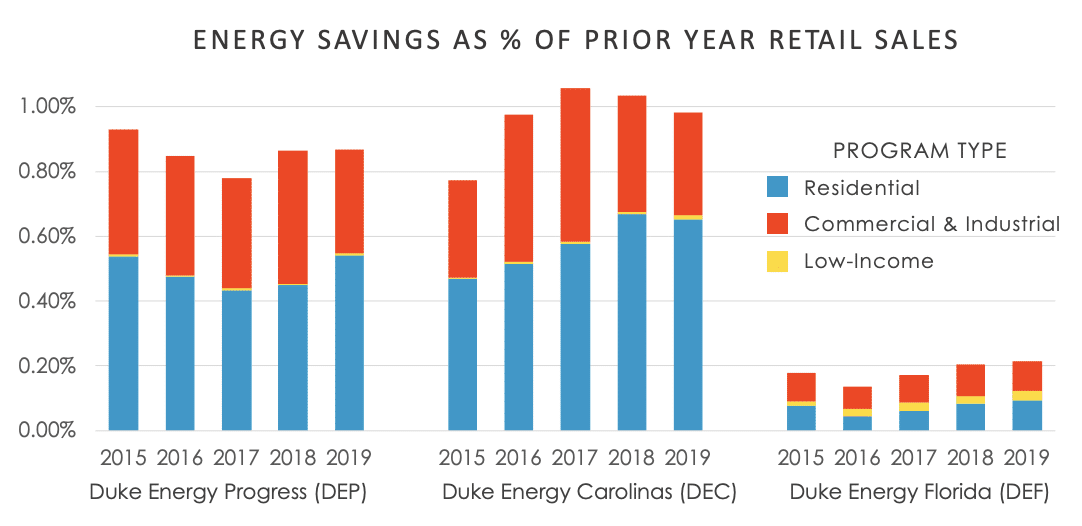This is the second in a series of blogs tied to SACE’s Third Annual Energy Efficiency in the Southeast Annual Report. In the coming weeks, additional blogs will highlight individual states, utilities, and key trends affecting energy efficiency in the region.
Each year SACE compiles efficiency performance data from nearly 500 electric utilities in the Southeast. Our analysis reveals nearly three-quarters of the region’s total energy efficiency savings come from just three companies: Duke Energy Carolinas (DEC), Duke Energy Progress (DEP), and Georgia Power.
[button color=”blue” url=”https://bit.ly/seeereport21″]Download the Report[/button]
[button color=”blue” url=”https://cleanenergy.org/?s=SEEnergyEfficiencyReport2021″]Read the Report Series[/button]
[button color=”blue” url=”https://cleanenergy.org/news-and-resources/energy-efficiency-in-the-southeast-third-annual-report-webinar/”]Watch the report webinar[/button]
Duke Leads Utilities in the Southeast in Efficiency
Duke Energy (including DEC and DEP in North and South Carolina, and Duke Energy Florida) was the top performer in the Southeast for percentage annual savings at 0.76% in 2019. This was more than double Dominion Energy South Carolina (0.32%); nearly triple both Southern Company (0.28%) and the regional average (0.26%). Duke Energy Carolinas once again led the region for individual utility efficiency performance, though it fell short of the 1% annual savings mark for the first time in three years. In fact, Duke’s three utilities account for 20% of the region’s retail electric sales, but in 2019 delivered 59% of total efficiency savings. This performance contrasts sharply with under-performance by the region’s remaining utilities, particularly Nextera and TVA.

Duke Needs to Measure Up to National Leaders
While Duke appears impressive compared to its Southeastern peers, taken from a broader perspective it is easy to see that the company should continue to strive toward higher efficiency performance. The national average for efficiency is 0.67%, but this includes a multitude of smaller electric companies, co-ops, and municipal utilities that do little or no efficiency. In an analysis of the nation’s 52 largest electric utilities, the American Council for an Energy Efficient Economy determined that the average annual efficiency savings for major utilities were 1.03% in 2018, substantially above Duke Energy’s average of 0.76% for its three Southeastern utilities. Even with the region’s best performance, Duke Energy Carolinas’ 0.98% annual savings is below the 2018 average for major U.S. utilities. At the top, more than a dozen utilities have annual savings of over 1.5%, with the highest coming in at more than 3% annual savings.

Changes in Policy Landscape are Key to Higher Efficiency
Duke’s most obvious area for improvement is Duke Energy Florida, where savings levels are just 0.19% – well below the regional average and just one-fifth of the savings performance by sister company Duke Energy Carolinas. The Florida Public Service Commission is now revising its energy efficiency rules. With the company’s more impressive performance experience in the Carolinas, Duke is uniquely positioned to help shape the direction of Florida’s new efficiency rules.

The rules governing Duke’s efficiency work in the Carolinas have also been revised periodically in response to lessons learned and national policy trends. In 2020 the North and South Carolina Commissions approved several changes that are expected to spur additional savings in coming years, including:
- Modifying Duke’s performance incentive bonus to reward the utilities for achieving 1% annual savings.
- Creating a new performance mechanism for reaching higher savings levels through low-income efficiency programs.
- Switching the primary cost-effectiveness criteria from the Total Resource Cost test to the Utility Cost Test, which compares only utility costs and benefits. The Commission also acknowledged that its previous approach, the TRC test, was asymmetrical – including all utility and customer costs, but excluding many of the corresponding customer benefits.
- Directed Duke to work with stakeholders of its energy efficiency Collaborative to better account for non-energy benefits.
- Called for a study of participation rates and savings impacts for low-income customers delivered through non-income qualified programs. This is part of an overall effort to increase savings for low-income households.
Where are the Additional Savings Opportunities for Duke?
In a subsequent blog, we will explore an array of policy factors and new strategies that could lead to higher efficiency savings for Duke in the future. These include new and modified programs, improved cost-effectiveness, commercial and industrial savings, and higher levels of efficiency in integrated resource planning.
Efficiency is a large and multifaceted energy resource, with the potential to solve many issues. In addition to helping customers lower their energy bills, efficiency is key to our efforts to retire outdated power plants, reduce the need for new fossil generation, and cut carbon emissions – while also creating new jobs and local economic development.
Even for the Southeast’s regional leader, there is tremendous untapped potential for efficiency. But developing and deploying successful programs to capture new energy savings takes commitment, flexibility, problem-solving, and supportive regulatory policies. Duke has outperformed its regional peers on efficiency for many years now, and in many ways is the best positioned to build on its past performance to reach new levels of energy savings in the coming years.
Find out more from our third annual “Energy Efficiency in the Southeast” Report and stay tuned for future editions in this blog series:
[button color=”blue” url=”https://bit.ly/seeereport21″]Download the Report[/button]
[button color=”blue” url=”https://cleanenergy.org/?s=SEEnergyEfficiencyReport2021″]Read the Report Series[/button]
[button color=”blue” url=”https://cleanenergy.org/news-and-resources/energy-efficiency-in-the-southeast-third-annual-report-webinar/”]Watch the report webinar[/button]
#SEEnergyEfficiencyReport2021



